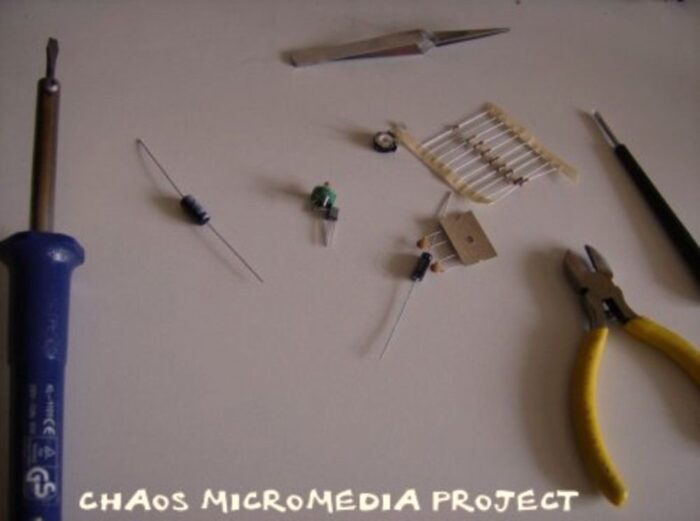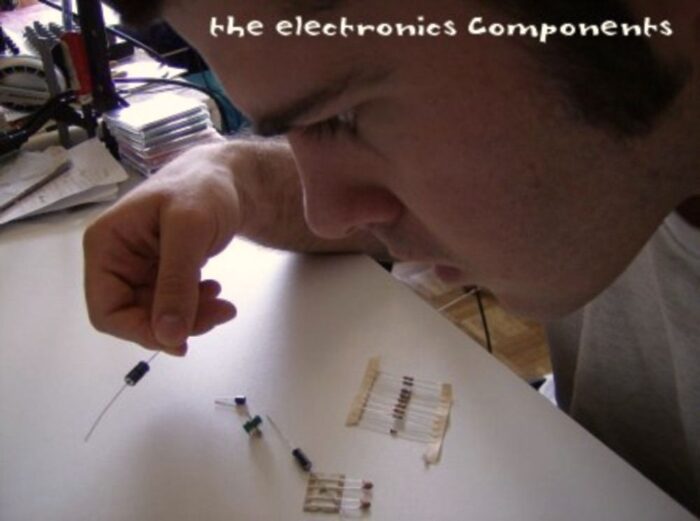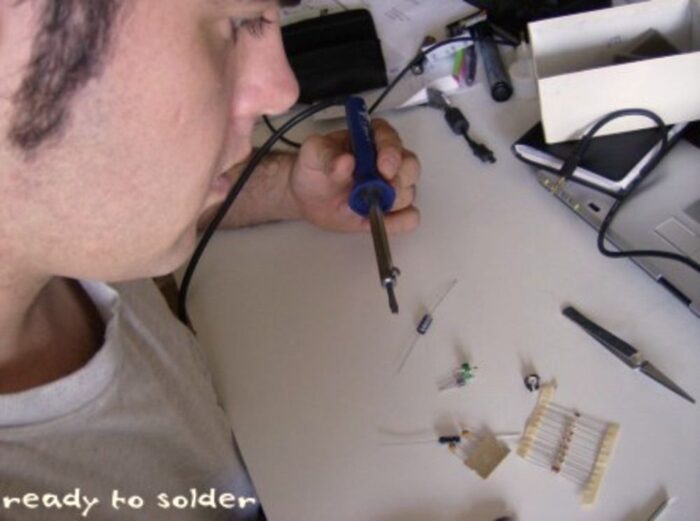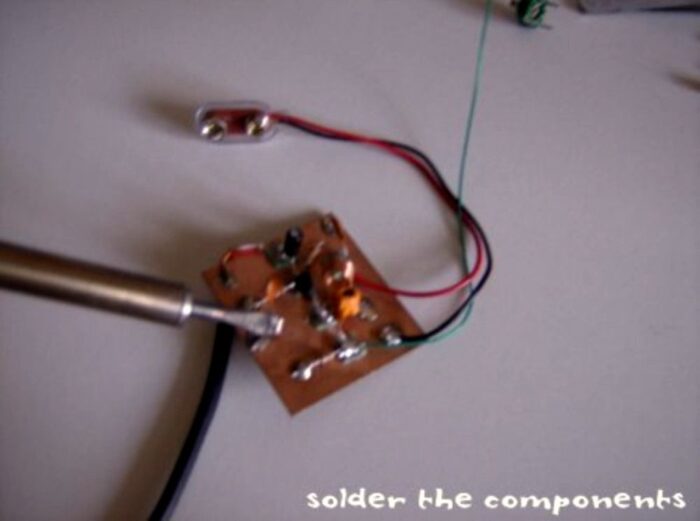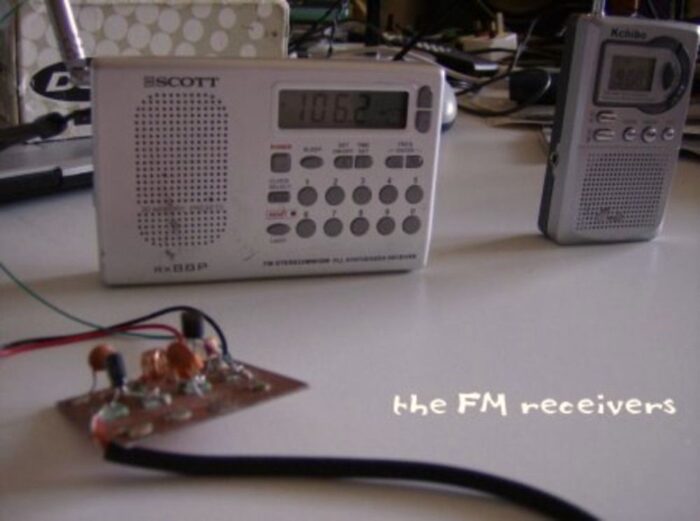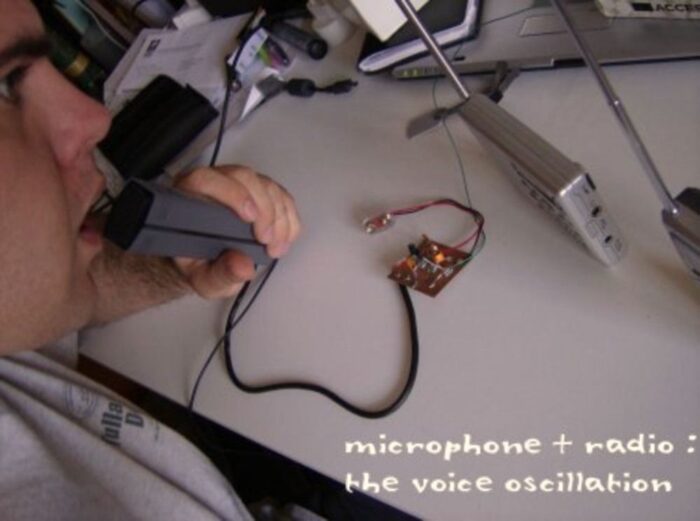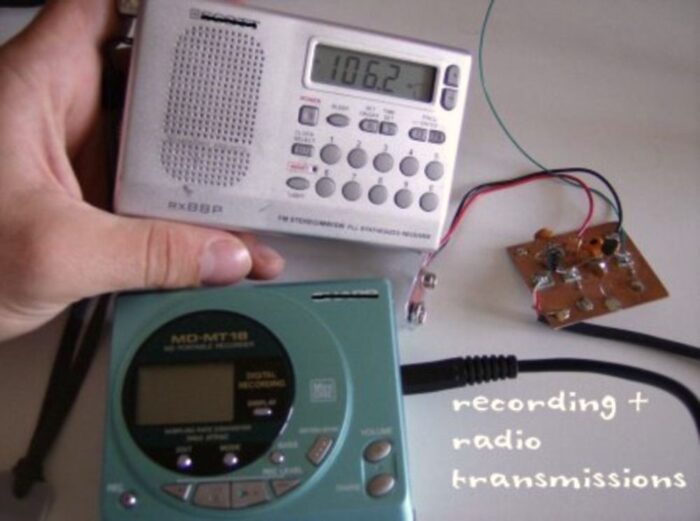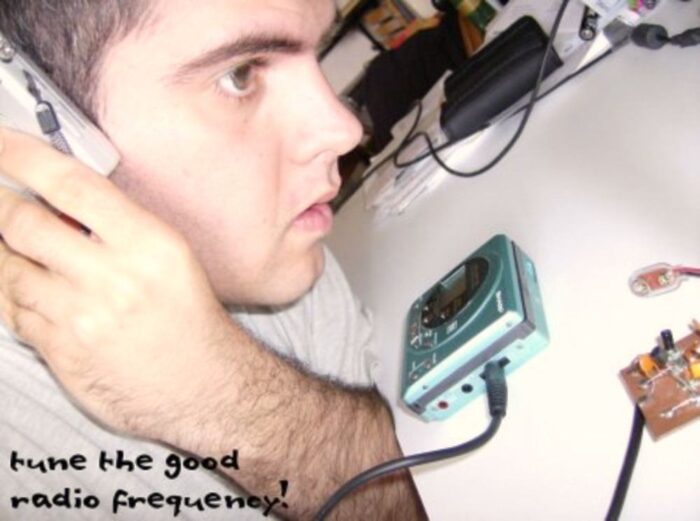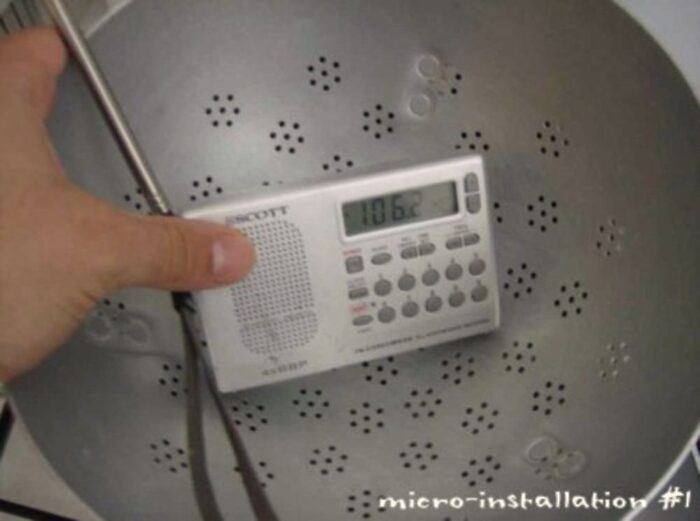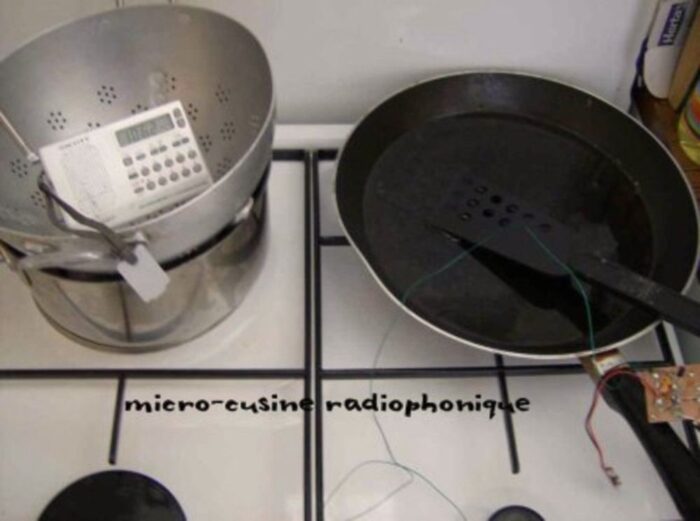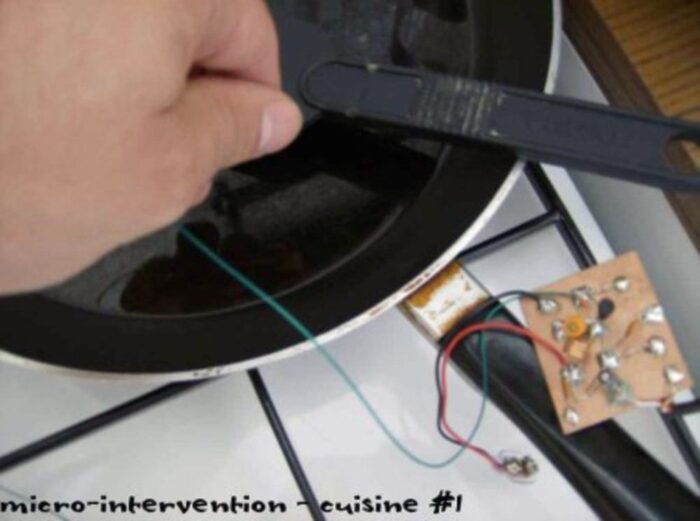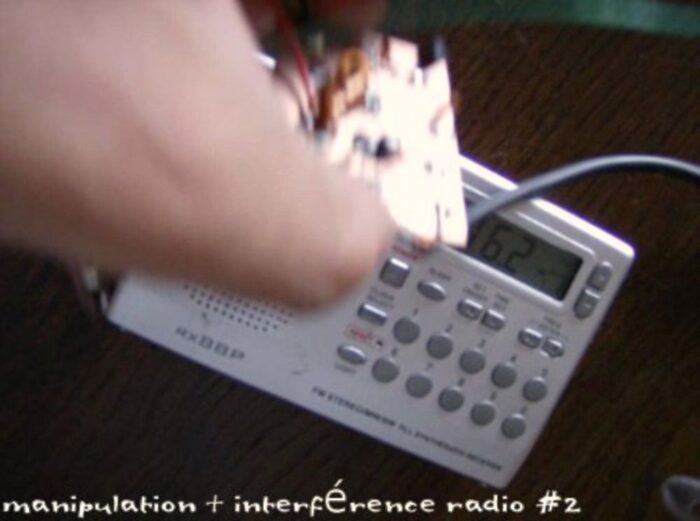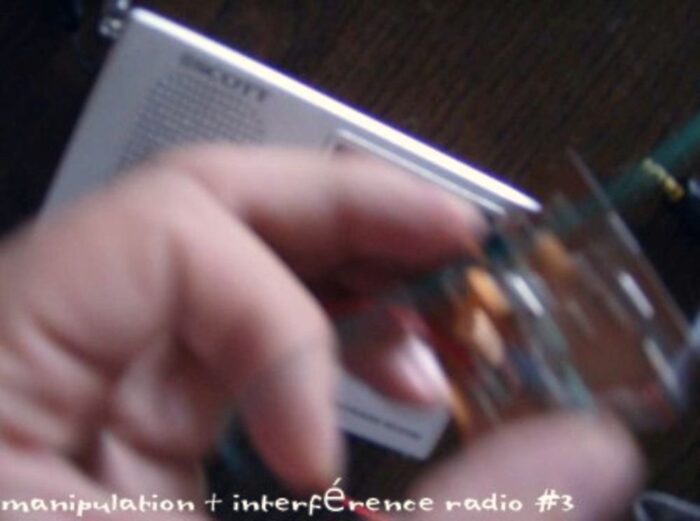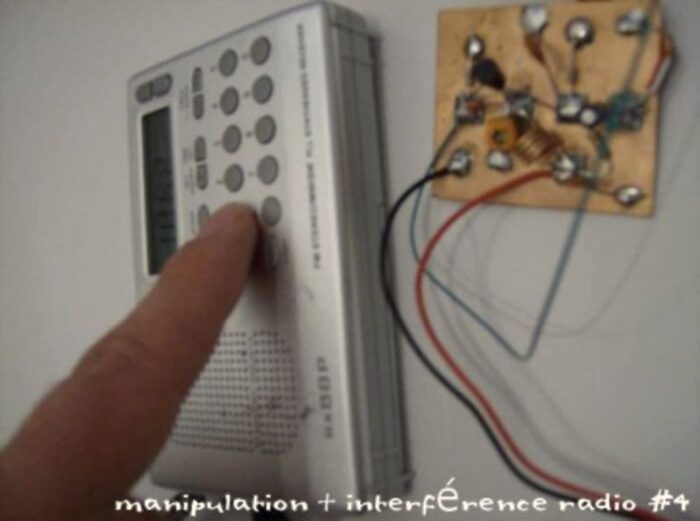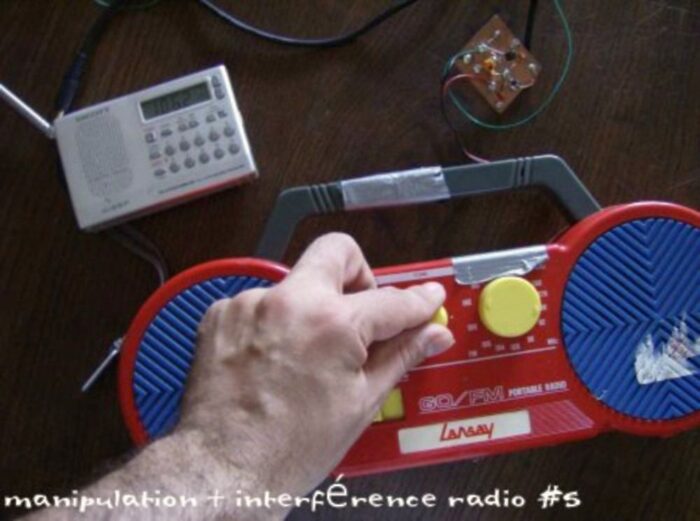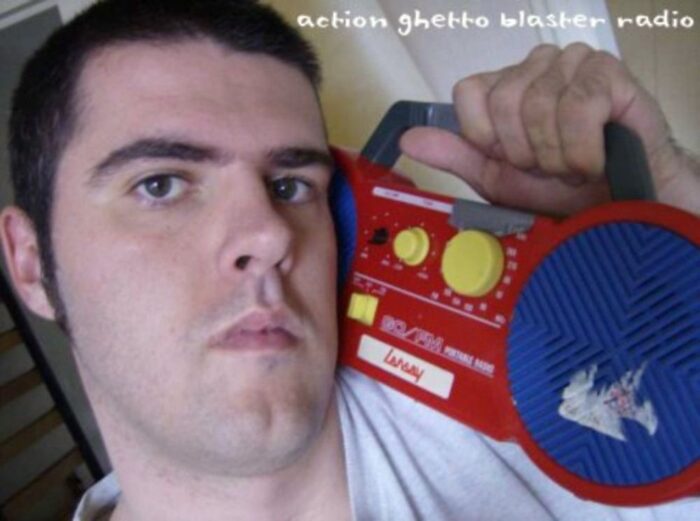The Chaos Micromedias project (inspired by Tetsuo Kogawa’s microradio) is a new kind of medialab based on hacking and hijacking electronics and FM/TV transmitters to generate noise and images at the micro level. It is structured around workshop sessions where participants build electronic sound devices—microphones, mixers, oscillators, audio amplifiers, controllers—as well as FM/TV transmitters. The project also features performances and micro-installations that diffuse sound through small, mobile radio receivers and various types of televisions. Sounds and images captured in the intervention space are reintroduced into the context via mobile diffusion systems, transformed using PureData automatons, and streamed on the internet.
This project positions micro versus mass, DIY electronics versus commercial dependency, and low-tech creativity versus high-tech constraints. By creating a space for micromedia construction and action, the Chaos Micromedias project challenges dominant media infrastructures, offering a participatory and hands-on approach to experimentation.
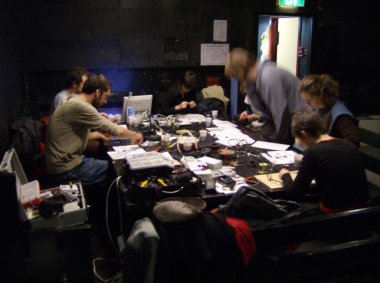
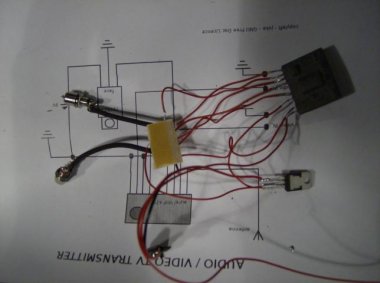
Reclaiming Technology: The Piksel Experiment
At the 2006 Piksel Festival in Bergen, Norway, an artificial intelligence researcher voiced concerns over the creeping cyborgian future—the replacement of damaged human brain parts with electronic devices. In contrast, the Chaos Micromedia Project offered an alternative perspective on technological evolution. Within a bunker hidden beneath damp Nordic rocks, hackers, artists, and experimental technologists engaged in radical exploration, treating technology as a potential for disruption rather than a means of control.
For four days, this underground laboratory became a site of intensive experimentation. Participants constructed micro-devices, turning soldering irons into tools for unlocking electromagnetic possibilities. Radio and TV transmitters, microphones, oscillators, and amplifiers transformed the bunker into an immersive media playground, disrupting the boundary between physical and mental spaces. A maelström of signals flooded the area, as feedback loops, wave interferences, and spectral transmissions reshaped the environment. This spectralisation of the waves revealed the hidden forces that dictate modern media landscapes.
Micromedia as a Tool for Subversion
As the experiment unfolded, the devices left the confines of the bunker and became prosthetic extensions of the body. Participants turned themselves into walking transmitters, broadcasting signals, feedback, and voices as they navigated the city. Their interventions transformed public spaces into interactive soundscapes. Julien deployed an autonomous oscillator and radio receiver, letting it interact with the urban landscape. Jörg played a light-sensitive oscillator like a musical instrument, while Christian grafted a reactive device onto his arm. Esther amplified and distorted her voice through a loudspeaker taped to her hip, and Sophie used a radio transmitter as a “second mouth.”
These actions sparked new, unexpected interactions. Sophie handed her radio to Esther, who acted as a relay, merging their voices into a hybrid transmission. Jörg layered feedback loops into the evolving media ecology. Julien’s automaton altered pedestrian movement, subtly shifting spatial dynamics. The project blurred lines between human and machine, performer and audience, introducing a new model of micromedia activism that resisted conventional media hierarchies.
The Politics of Waves and Limits
The Chaos Micromedia Project extends beyond technical exploration into the realm of political and social critique. It challenges traditional boundaries of media consumption and production, raising fundamental questions about the limits and possibilities of communication. Working with electromagnetic waves leads us to interrogate their range: how do we define their perimeter? Can we probe, chart, or even explode their limits? What is the significance of transmission, oscillation, and broadcast when these processes are performed in alternative contexts with self-built tools?
This project also questions the role of medialabs. What social forms emerge when a medialab is activated? Can micromedia structures influence micro-events—shifting relationships, altering territories, transforming knowledge and memory? The Chaos Micromedia Project creates a micro-society where micro-displacements lead to micro-events, which in turn generate micro-climates that disrupt conventional borders and hierarchies.
Beyond Limits: The Future of Micromedia
The core of the Chaos Micromedia Project lies in its potential for transformation. Limits—whether social, technological, or conceptual—are not just defined but actively redefined. By extending, reducing, or subverting limits, micromedia opens up new possibilities for intervention and experimentation. These micro-transformations can, in turn, alter spaces, challenge power structures, and redefine the scale of communication and artistic expression.
Through this lens, the cyborgian future ceases to be a dystopian inevitability of control and surveillance. Instead, hacked micro-devices become vectors of permutation, enabling new configurations of interaction and collective existence. Borrowing from Michel Foucault’s idea of the end of man, the Chaos Micromedia Project suggests a future where technology is reclaimed as a tool for radical reconfiguration—where the body, space, and waves converge in dynamic interplay, and where the micro disrupts the macro.
By Apo33 – GNUDocumentation 2006/2025
CHAOS MICROMEDIA MANIFESTO
MICROMEDIA AGAINST MASS CONTROL
We reject the dominance of mass media, corporate-controlled networks, and the passive consumption of pre-packaged content. Chaos Micromedia emerges as an act of defiance—a counterforce to centralized media control. We create noise, not silence. We hijack, not obey. We transmit, not consume.
HACK, HIJACK, TRANSMIT
We reclaim technology from the grips of industry. Our tools are hacked, our transmitters hijacked, our signals raw. We construct our own electronic devices—microphones, mixers, oscillators, amplifiers—subverting the authority of factory-made dependency. Every circuit we forge is an act of resistance.
MICRO-VERSUS-MASS
We champion the small, the localized, the decentralized. Micromedia is the anti-monument, the ephemeral act of communication that fractures the mass into multiplicities. Where the mass dictates uniformity, we embrace the chaotic, the unpredictable, the transient.
SOUND AND IMAGE AS WEAPONS
The airwaves belong to all, not to the privileged few. We use FM/TV transmitters as disruptive instruments, filling the ether with signals of interference, creating new sonic and visual territories. We turn the invisible into the tangible, the unheard into the deafening.
MOBILE DISRUPTION, TEMPORARY AUTONOMY
Our interventions are nomadic. Sound and image are captured in real time, transformed, and reintroduced through mobile diffusion systems. We stream live, disrupting fixed media boundaries. We construct ephemeral zones of autonomy where media flows freely and unpredictably.
LOW-TECH, HIGH IMPACT
We reject technological elitism. The power of transmission does not belong to corporations; it belongs to anyone who dares to build, to hack, to send signals into the void. DIY is not just a method—it is a statement of autonomy, a call to reclaim technology from capitalist production cycles.
PURE CHAOS, PURE DATA
We manipulate sound and image through open-source tools like PureData, rejecting proprietary software that locks creativity behind paywalls. Our transmissions are generative, unpredictable, and uncontrollable. We embrace the glitch, the feedback loop, the distortion.
A MEDIA ECOLOGY OF RESISTANCE
We construct micromedia spaces where experimentation thrives, where the act of broadcasting becomes an act of liberation. We create micro-disruptions that ripple into macro-resistance. We operate outside corporate structures, refusing compliance, embracing chaos.
TRANSMISSION AS ACTION
We do not ask for permission. We do not wait for approval. We transmit now. Our media exists in the moment of its transmission, in the instant of its disruption. Each signal sent is an act of defiance, an assertion of creative and political autonomy.
JOIN THE CHAOS
Chaos Micromedia is not a project; it is an open call to action. Build. Hack. Transmit. Transform. Every sound, every image, every hacked device is a step towards reclaiming the media landscape. The future is unwritten, the frequencies are open—take them.
Chaos Micromedia Project: Practical Manual
Introduction
The Chaos Micromedia Project is an experiment in hacking, hijacking, and re-appropriating technology for the creation of autonomous and ephemeral media. This manual serves as a guide to building and deploying DIY FM/TV transmitters, amplifiers, and sound devices to create localized micro-broadcasts and experimental media environments.
1. Selecting the Right Components
Before starting, gather the necessary components based on your desired setup:
- Transmitters: TV transmitter, FM/AM radio transmitter
- Audio Equipment: Microphones, mixers, oscillators, audio amplifiers
- Video Equipment: Cameras, video transmitters
- Power Supply: Batteries or external power sources
- Interference Tools: Radio receivers, TV sets, portable radios
Make sure to have a schematic ready for assembling the circuits.
2. Preparing for Assembly
- Set up your workstation with adequate lighting and ventilation.
- Gather your tools: soldering iron, solder, wire cutters, pliers, PCB board.
- Arrange components for easy access.
3. Building the Circuit
- Follow your schematic carefully.
- Solder each component onto the board, ensuring solid connections.
- Double-check for loose or misplaced components.
- Avoid short circuits by trimming excess wire leads.
4. Testing Your Circuit
- Connect the circuit to a power source.
- Use radio and TV receivers to detect signals.
- If no signal is detected, troubleshoot by checking solder joints and component placement.
- Adjust antenna positioning for optimal transmission range.
5. Sending Audio and Video Signals
- Connect a microphone or pre-recorded sound source to the radio transmitter.
- For TV transmission, use a video camera or video feed.
- Modulate the input signal for desired effects.
6. Tuning Your Frequencies
- Adjust the frequency on the radio and TV to match the transmitters.
- Fine-tune settings to minimize interference and optimize clarity.
- Experiment with different frequency bands for unique transmission effects.
7. Launching the Installation & Performance
- Set up your transmitters in various locations.
- Cook and transmit! Experiment with multi-sensory interventions.
- Broadcast live soundscapes, noise performances, and unexpected media disruptions.
8. Performing with the Waves
- Engage with the surrounding environment through sound and image.
- Move through space while transmitting, creating ephemeral media landscapes.
- Layer signals dynamically to alter perception.
9. Generating Interference & Feedback
- Introduce deliberate distortions and disruptions.
- Manipulate feedback loops to create sonic and visual overload.
- Experiment with environmental reflections and signal decay.
10. Hacking the Neighborhood with Portable Devices
- Use portable radios, ghetto blasters, and handheld receivers to expand transmission reach.
- Move through different areas, inserting disruptions into public spaces.
- Transform everyday environments into temporary zones of autonomous media.
Food for Thoughts
The Chaos Micromedia Project is about reclaiming the media landscape, engaging with the materiality of transmission, and creating interventions that defy the passive consumption of mass media. Hack, build, transmit, disrupt. The waves are yours to manipulate.
Photos manual
https://apo33.org/cia/doku.php?id=micromedia:look_at_some_photos_story_about_it
